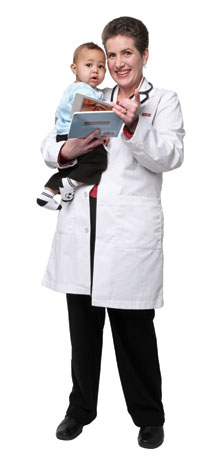 Dr. Jill Sells is a pediatrician and cofounder (with Dr. Mary Ann Woodruff) of Reach Out and Read Washington State, a regional office of Reach Out and Read (ROR), a national program that serves about 4 million children each year. At children’s medical checkups, ROR doctors and nurses talk with parents about the importance of reading to their young children and give each child, ages 6 months through 5 years, a new book to take home.
Dr. Jill Sells is a pediatrician and cofounder (with Dr. Mary Ann Woodruff) of Reach Out and Read Washington State, a regional office of Reach Out and Read (ROR), a national program that serves about 4 million children each year. At children’s medical checkups, ROR doctors and nurses talk with parents about the importance of reading to their young children and give each child, ages 6 months through 5 years, a new book to take home.
Where did the idea for Reach Out and Read come from?
Pediatricians and early childhood educators in Boston realized that many families, especially those who were low-income, did not have books at home, and that doctors were in a perfect position to prescribe books and encourage families to read together.
From the first program at Boston City Hospital (now Boston Medical Center), Reach Out and Read has grown to almost 5,000 programs across all 50 states. The program in Washington state started in 1997 and has grown from 52 to 146 programs, now serving about 86,000 children and their families.
What kind of need is there for this program in Washington state? Nationally?
Huge. Early brain, education and economic research all point to the same conclusion: If we invest early and wisely in our educational system, we will have better outcomes and lower costs.
Language and literacy outcomes must improve. According to studies, in Washington state:
- One-third of children do not read proficiently by the end of third grade, a time when students transition from “learning to read” to “reading to learn.”
- One-third of kindergartners enter school without age-appropriate language and literacy skills.
- National data shows that differences are measurable as early as 9 months of age.
- At all ages, children of color or living in low-income families are doing less well than their peers.
What age group do you target and why?
Our doctors support parents and children (from birth through age 5) together. In 1989, pediatricians recognized that changing children’s language and reading environment at home starting in infancy would help them be ready for school. They saw that kids who were behind in the early years rarely caught up with their peers. Reach Out and Read works to improve children’s readiness for kindergarten by supporting their parents as their first teachers.
Do you work with a particular medical group or hospital?
So far, we work with 146 different clinics in Washington state, including in community health centers, HMOs, hospital-affiliated clinics, military health facilities and private practices. We want to be wherever children are receiving checkups.
How do you choose the books — and where do they come from?
Each medical practice chooses books to meet the needs of the patients they serve. Doctors can obtain books through any means they want, but most find that the best deals for high-quality books are in the Reach Out and Read catalog. It contains books for children up through age 5 years at huge discounts, has books in 14 different languages and is updated every year.
How did you become interested in early reading development?
I loved books as a kid, and then in college, I studied child development and became fascinated by how young children learn. I always wanted to help kids, so I became a pediatrician.
My work with Reach Out and Read evolved out of my desire to help parents soon after I became one myself. Babies were on the cover of Newsweek, and Gov. Locke (whose first child was born the same week as mine!) had created the Governor’s Commission on Early Learning. It seemed obvious to me that children’s doctors should be frontline providers of early learning information and support, so I began trying to explore how we could do that better.
In 2007, I partnered with Tacoma pediatrician Dr. Mary Ann Woodruff and Reach Out and Read to start Reach Out and Read Washington State.
My interest likely comes from both my genes and my environment — my dad is a pediatrician, and my mom was a teacher. Then I grew up to be a pediatrician who married a teacher. We see the intersections between home life, health, school and student outcomes every day in our own household and in our work. We are pleased that we are parenting two awesome (now preteen and teen) readers. We know their love for books has already made a huge difference in their lives, and we want that for all kids.
Why go through doctors rather than working with parents or school early learning programs?
Three main reasons: This is where young families are; it’s what parents want; and, most importantly, it works. Parents trust their child’s health-care provider.
First, the doctor’s office is the only place that nearly every child can be found. A study in two of Washington’s communities where children are at particular risk for poor outcomes showed that 96% of young children had received a checkup in the previous year. By contrast, 50% of children in Washington are regularly cared for only by their parent or guardian before they turn 6, meaning they are not in either formal or informal child care or preschool programs. That number is astounding. It means that unless we find a way to directly reach parents, we will miss at least half of all kids in the state before they get to kindergarten! And just as important, I always encourage people to remember what should be obvious — that all kids have parents or someone in the parental role, and that they are the most influential people in young children’s lives.
Secondly, families seek parenting support from their children’s doctors. When the Washington State Department of Early Learning asked families across the state who they most trusted and wanted to get early learning information from, the top answer by far was their child’s health provider.
Finally, Reach Out and Read works! Our evidence-based national program has a 23-year history backed by 15 published studies showing efficacy. When families participate parents read aloud more often at home, children show improved language skills, and they are more likely to arrive at kindergarten with the early literacy skills they need.
Is there any training doctors go through to be a part of the program?
All clinics go through a formal (but not overly burdensome) process to participate in Reach Out and Read. First, they complete an online application. Once book funding is identified, the application approved. Then each primary care provider (pediatrician, family physician, nurse practitioner or physician’s assistant) completes an online Continuing Medical Education course. Video vignettes demonstrate how doctors use a children’s book to help assess child development as they teach parents how to support their child’s early language and literacy skills at home. Reach Out and Read Washington staff provides ongoing technical assistance and professional development services to both the doctors and the clinics to support high quality programs within a busy medical setting.
How is this program funded?
We are a regional office of Reach Out and Read, Inc., a national 501c3 not-for-profit organization. As Executive Director for Washington, I am responsible for raising most of the funds needed in the state. The investment cost for Reach Out and Read is only $17 per child per year, and our current statewide budget is about $1.4 million. But for each $1 invested, medical providers contribute services valued at $8. Because of this, Reach Out and Read is extraordinarily efficient and cost-effective.
We blend public and private funds, and our major funders are the Bill & Melinda Gates Foundation, the Washington State Department of Early Learning, Thrive by Five Washington, the Bezos Family Foundation, the federal Maternal and Child Health Bureau, and the Boeing Company. We and our medical practices also obtain community-based funding from United Way, foundations, businesses, service clubs, and individuals. Despite the low cost, establishing sustainable funding for the program is a continual challenge and we are not there yet. Many of our programs do not have all the books they need, and the most common barrier that keeps doctors from joining the program is lack of funding for books.
How can parents get involved in the program if their doctor is not a participant?
They can ask their doctors to participate in Reach Out and Read, and encourage them to contact Reach Out and Read Washington State. We will explain the application process and the program. In some cases we have funding that will help them get started, and in all cases we will brainstorm potential funding sources. Right now we having funding to help us recruit programs in South King County — so send them our way! Our job is to make it as easy as possible for medical providers to participate. The worst case scenario is that programs will be wait-listed until funding is available. This will demonstrate demand from families and interest from doctors, and will strengthen the case for increased investment in Reach Out and Read.
What educational impact does this program have on a participating child?
When families participate in Reach Out and Read, parents read aloud more often at home, children show improved language skills, and they are more likely to arrive at kindergarten with the early literacy skills they need. During the preschool years, children served by Reach Out and Read score three to six months ahead of their non–Reach Out and Read peers on vocabulary tests.
These early foundational language skills help start children on a path of success when they enter school. Improving early literacy skills increases children’s readiness for school, which in turn improves their likelihood of achieving reading success by the end of third grade, a strong predictor of high school graduation.
What is the best way for program fans to help? Do you accept book donations?
We encourage donations of funds to purchase books, rather than books themselves, because that is the best way to help our programs. We can target donations to the clinics that need support the most, or we can direct them to the clinic of a donor’s choice. Doctors’ offices have very little storage space, and they need to have books that match the age and needs of each child they see.
We also want each dollar to stretch as far as possible. Our nationally negotiated publisher discounts enable our practices to buy the right books for their patients at precisely the time they need them, for the lowest possible price — averaging $2.75 per book. Some clinics do accept donations of new or gently used books. Interested donors should contact our office, and we can try to match them with a clinic.
Is there a campaign benefiting ROR?
Reach Out and Read will receive 15 percent of all of the proceeds from the sale of Hanna Andersson’s valentine-print long johns through March 10. Go to “Pajamas for a great cause” at reachoutandread.org or any Hanna Andersson store.
How can our readers help boost success in Washington?
We believe that there is considerable untapped potential support for Reach Out and Read in Washington state. Here are some ways to help:
- Encourage doctors to participate: Talk to your child’s doctor and any others you know. Tell them about the program, show them this story and tell them we want to help them get started. Many doctors have never heard of Reach Out and Read, or don’t know they can participate.
- Help support Reach Out and Read: The program is really inexpensive, but limited funding is what is slowing down the process of expansion. We know there are many people in Washington who would support this, if only they were encouraged to do so and knew how to help.
Other ideas:
- Are you or others you know in a position to make a charitable contribution to Reach Out and Read Washington State?
- Do you know any businesses, foundations or service groups (Rotary, Kiwanis, Lions, etc.) looking for a good cause to support?
- Do you belong to a book club, parent group, religious or service organization that might want to pool funds to support a great cause?
Funding through the state budget process is one of the most efficient ways to help bring the program to kids across the state. Reach Out and Read has strong supporters in both chambers and parties, and we are hopeful for improved funding in this year’s budget. To contact your legislator and request support for Reach Out and Read, go here.
If every reader helps support Reach Out and Read, we will be able to benefit many more children and families. Together we can make this a reality. Find more information at Reach Out and Read Washington.










